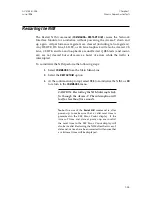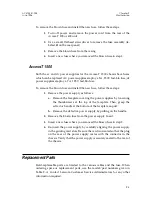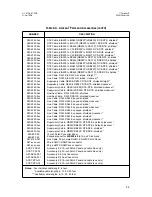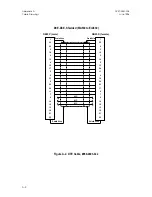
Summary of Alarm Identification in Master Mode
You can learn of an alarm in an Access-T chain in several ways:
•
If you are directly connected to the master Access-T, you will see the
ALERT indication appear in the Title Bar.
•
If you are connected to the master Access-T via modems, Access-T
will dial a connection, and you will receive either a one-line alarm
banner, a TABS report, or a trap message, as described under Alarm
Reporting Method
in Chapter 6.
In either case, the procedure for locating the alarm via the Terinal Interface is as
follows:
1.
Make sure that the master Access-T is selected, and not one of the
slaves. (You can do so by typing
?
.)
2.
View the Chain Port Polling History. Determine whether the alarm
has been caused by a slave which is not responding.
If not, go to step 3.
If so, take whatever action is necessary to allow the master to poll the
non-responding slave. The problem may be caused by a faulty con-
nection to the slave or by a failure of the slave.
3.
View the Node Alarm Status. Determine the node(s) at which an
uncleared alarm exists by looking for
YES
in the column headed
ALARMS
.
4.
Once you have determined that an alarm exists at a node, you can
view and clear the alarm just as you would at the master Access-T.
The basic procedure is as follows:
a.
Select the node at which the alarm exists. (Selecting nodes is
described earlier in this chapter.)
b.
View the Alarm History as described in Chapter 7.
c.
Clear the Alarm History as described in Chapter 7.
Note:
As an alternative to substeps 4b and 4c, you can
issue the
CLEAR—ALARM HISTORY—FORCE
command
which will clear
all
alarms (viewed or unviewed) in the
requested history.
ACST-0351-005
Chapter 8
June 1996
Using Access-T as a Master
8-13
















































